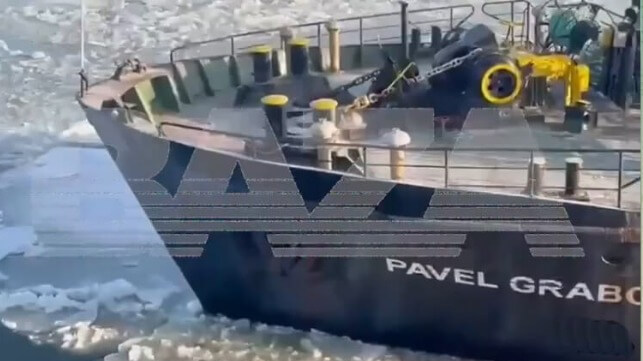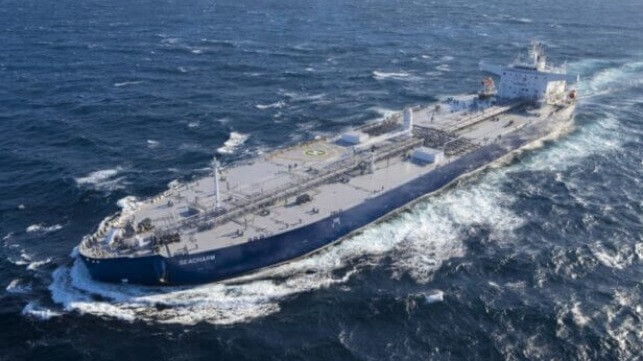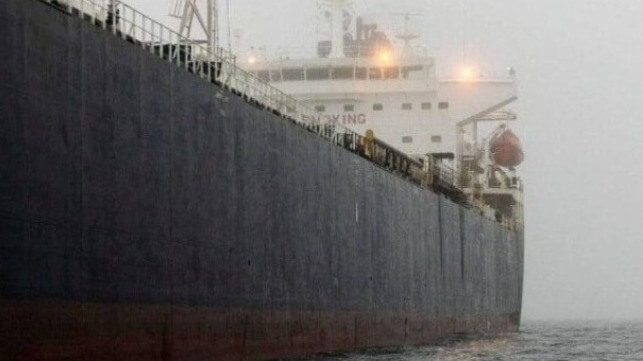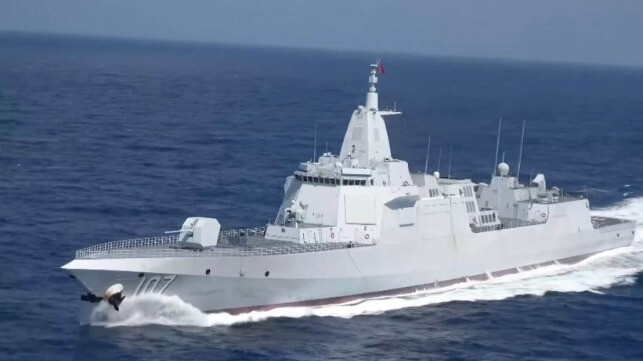Mystery Surrounds Reports of Cargo Ship in Distress in Sea of Azov

Russian authorities are denying media reports that another one of the decrepit fleet of ancient cargo ships operating on the Sea of Azov is in distress. The media is saying the vessel was taking on water while the authorities insist the vessel was in port and repaired.
The general cargo ship Pavel Grabovsky, built in 1979, loaded a cargo of 3,000 tons of corn and departed Rostov-on-Don bound for Turkey. After passing the city of Azov, the vessel reportedly encountered ice and was damaged on February 16 without issuing a distress call.
The media indicated the vessel struck ice and the crew was attempting to control the flooding with its pumps. However, at some point during the week, the crew realized they were not able to control the flooding and asked for permission to return to Azov.
The reports vary from here with the media saying the ship had too deep a draft and due to water levels was unable to reach the port and went aground. The icebreakers Kapiran Demidov and Kapitan Chudinnov were reported to be making their way to assist the vessel.
TASS issued an official report denying the media accounts and saying the vessel had reached Azov and repairs were made. They however are admitting the vessel went aground but said it was due to weather conditions as the cargo ship was departing Azov to resume its trip to Turkey. Citing the Ministry of Transport, TASS indicates that when the weather improves and sea levels rise, the vessel will be removed from the roadstead and the owner will make further repairs.
The vessel is registered in Panama and 3,100 dwt. Equasis indicates it has been under the management of a Turkish company since 2013. The Pavel Grabovsky had a similar incident in 2013 when it had to be rescued after stranding. At the time, it was registered in Sierra Leone. There was a crew of 14 aboard and they had loaded a cargo of wheat. The ship went aground in the port of Azov.
Records show the vessel was inspected at the end of January 2025 in Georgia. The report lists eight deficiencies but no detention order was issued. The issues ranged from problems with the life saving equipment to piping, electrical, safety of the pilot ladders, and documentation.
After two incidents at the end of 2024 involving Russian sea-river tankers near the Kerch Strait at the exit from the Sea of Azov, the Russian Ministry of Transport reportedly issued an inspection order for all the old vessels operating in the region. Officials indicated as many as 500 shipping companies and their vessels would be subject to the inspections as part of an effort to improve the image of shipping and the response to the oil spill from one of the tankers lost in December.
Authorities Explore if Tankers in the Russian Oil Trade Are Being Targeted

Italian authorities are confirming that they have widened the investigation into damage to a Greek-owned tanker offloading last week in a northern Italian port. According to multiple media reports, the investigation is looking at terrorism as details also emerged on two other incidents with tankers in recent weeks in the Mediterranean.
The anti-terrorism unit of Genoa’s Public Prosecutor’s Office has reportedly become involved in the incident that damaged the Greek-owned Seajewel (108,888 dwt) overnight between February 14 and 15. The Port Authority of Savona, Italy confirmed earlier this week that offloading operations had been suspended after anomalies were observed without specifying what happened.
The chief prosecutor told Reuters they have taken the data from the vessel’s “black box” as part of an investigation into possible terrorist activities. The report indicates divers found a 28 x 47-inch hole in the hull of the tanker. Previously the report said the plates were driven inward indicating external force. They also cited the presence of dead fish in the area.
The vessel’s owner Thenamaris of Greece confirmed that the crew was safe while also mentioning that there were third-party individuals involved in the offloading. They said the Greek authorities were also investigating and in the same statement said the investigation involved a second tanker, Seacharm (112,000 dwt) which had been damaged in January while sailing to Turkey.
That caused widespread speculation fueled by a report by Lloyd’s List that detailed yet another previously unreported incident involving a tanker. The reports indicate the product tanker Grace Ferrum (50,000 dwt) was damaged while at anchor in Libyan waters and remains at the port weeks later.
Bloomberg points out that both of the Thenamaris tankers in the past had called at Russia’s Novorossiysk port and previously transported Russian oil. They state that it appears neither tanker was violating sanctions carrying Russian oil this year when they were damaged. The Grace Ferrum had called at Ust-Luga in the Baltic. Russian authorities also asserted that another tanker, Koala, was attacked causing the explosion while it was in the port of Ust-Luga.
The four incidents all occurring in 2025 have prompted media speculation that vessels in the Russian oil trade are being targeted. Italian and Greek investigators will be looking into these allegations as they seek the cause of the damage to the Thenamaris tankers.
Adding to the speculation are also the allegations that the Russian cargo ship Ursa Major operating as a military sealift ship was attacked causing it to sink in December 2024. The operator of the vessel asserted it was an attack that sunk the vessel while the Russian fleet off Syria also came under pressure with reports of at least one fire aboard a ship being used as part of the Syrian evacuation.
Officials have said it is far too early to link these incidents. They could be a coincidence or possibly someone is targeting shipping supporting Russia.
U Plans to Add 73 More Tankers to Shadow Fleet Blacklist

As the Trump administration negotiates with Russian officials over a proposed truce in Ukraine, EU officials have released an initial outline of a 16th package of sanctions on Moscow, including 73 more vessels from Russia's "shadow fleet" of aging tankers.
"The EU is clamping down even harder on circumvention by targeting more vessels in Putin’s shadow fleet and imposing new import and export bans. We are committed to keep up the pressure on the Kremlin," said EU Commission President Ursula von der Leyen in a statement.
For the first time, the EU has placed restrictions on Russian seaports that are used for evading the G7 price cap on Russian oil. Kozmino, the terminal responsible for exporting the ESPO blend to Pacific buyers, has consistently violated the cap since it was imposed; Primorsk, Ust-Luga and Novorossiysk also routinely export Urals grade crude at prices over the limit.
Additional measures include a phased ban on Russian aluminum imports, along with new sanctions on specific Russian officials and banks.
"We keep supporting Ukraine and we keep sanctioning the Russian aggressor, because this is the right thing to do, preserving international rules and order," one EU diplomat told the FT.
Separately, European officials have leaked an early outline of a Franco-British plan to deploy a small peacekeeping force to Ukraine after a possible end of hostilities. The plan would comprise about 30,000 servicemembers, primarily for defending Ukraine's airspace and its sea lines of communication. The scheme would not put Western troops near the front line, where they could come into contact with Russian forces.
The position broadcast by the U.S. government focused on the commercial opportunities of a rapprochement with Moscow. In a statement Wednesday, the U.S. State Department said that it was negotiating with Russia to establish "future co-operation on matters of mutual geopolitical interest and historic economic and investment opportunities," along with a Ukrainian peace deal that Russia and the U.S. will determine.


